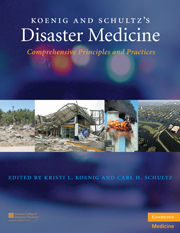Book contents
- Frontmatter
- Contents
- List of Contributors
- Contributor Biographies
- Foreword
- Preface
- Acknowledgments
- PART I CONCEPTUAL FRAMEWORK AND STRATEGIC OVERVIEW
- 1 Disaster Research and Epidemiology
- 2 Disaster Education and Training: Linking Individual and Organizational Learning and Performance
- 3 Surge Capacity
- 4 International Perspectives on Disaster Management
- 5 Ethical Issues in Disaster Medicine
- 6 Emerging Infectious Diseases: Concepts in Preparing for and Responding to the Next Microbial Threat
- 7 Disaster Mental and Behavioral Health
- 8 Special Needs Populations
- PART II OPERATIONAL ISSUES
- PART III CLINICAL MANAGEMENT
- Index
- Plate section
- References
8 - Special Needs Populations
from PART I - CONCEPTUAL FRAMEWORK AND STRATEGIC OVERVIEW
Published online by Cambridge University Press: 05 August 2011
- Frontmatter
- Contents
- List of Contributors
- Contributor Biographies
- Foreword
- Preface
- Acknowledgments
- PART I CONCEPTUAL FRAMEWORK AND STRATEGIC OVERVIEW
- 1 Disaster Research and Epidemiology
- 2 Disaster Education and Training: Linking Individual and Organizational Learning and Performance
- 3 Surge Capacity
- 4 International Perspectives on Disaster Management
- 5 Ethical Issues in Disaster Medicine
- 6 Emerging Infectious Diseases: Concepts in Preparing for and Responding to the Next Microbial Threat
- 7 Disaster Mental and Behavioral Health
- 8 Special Needs Populations
- PART II OPERATIONAL ISSUES
- PART III CLINICAL MANAGEMENT
- Index
- Plate section
- References
Summary
OVERVIEW
In studying the impact of disasters, concern has developed regarding populations that demonstrate a greater vulnerability to injury, death, and/or property loss. The term “special needs,” as well as vulnerable populations or populations at risk, has been applied to this group. These terms broadly cover a range of people who might need particular kinds of assistance in emergencies and disasters. Vulnerable populations include people with disabilities, senior citizens, pregnant women, infants and children, single parents, women, low-income families, and racial and ethnic minorities. Examples of unique interventions for such individuals are specially crafted warnings (in various languages and literacy levels), evacuation and transportation assistance, priority rescue, medical treatment, accessible sheltering, and assistance with rebuilding.
A broad-brush approach to vulnerability has certain benefits. First, a wider inclusion means that a given jurisdiction, organization, or community may contextualize the term. In some locations, it may be that the most vulnerable population includes senior citizens. In another location, it could be recent immigrants. Second, a broad approach captures a more complete list of those potentially at risk. Doing so allows emergency managers to understand the complexities of people's lives and circumstances. Sex, for example, can greatly increase risk in some contexts. Pregnancy may further complicate the ability to escape danger or can, itself, endanger both mother and fetus. Low-income households may lack the resources to afford protective action. If such households include seniors on fixed incomes, additional complications arise including transportation assistance and nutritional and medical support.
Keywords
- Type
- Chapter
- Information
- Koenig and Schultz's Disaster MedicineComprehensive Principles and Practices, pp. 113 - 130Publisher: Cambridge University PressPrint publication year: 2009



